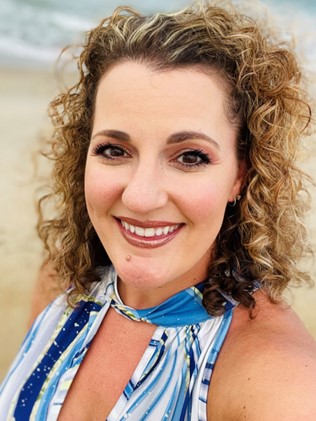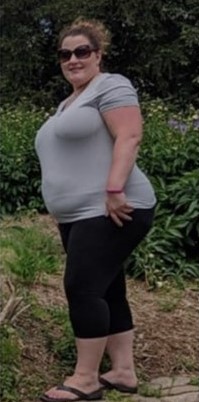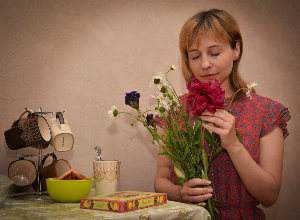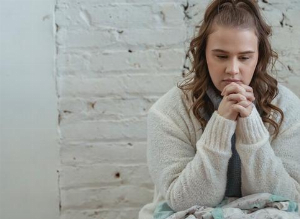Kasi: “After the fat-shaming and gaslighting, my Lipedema diagnosis came as a huge blessing."
Published Oct 4, 2023 • By Somya Pokharna
Kasi's story is one of resilience and transformation. After silently enduring the painful symptoms of Lipedema for nearly three decades, all the while having them misattributed to obesity, her life took a turn for the better with her long-awaited, definitive diagnosis at the age of 40. It marked the beginning of a profound journey of self-discovery and passionate advocacy for this often-misunderstood disorder.
In this inspiring interview, Kasi discusses her early encounters with the symptoms, the toll they took on her mental health and self-esteem, and the treatments and lifestyle changes she has embraced since her diagnosis. She also shares her vision for a future where Lipedema is recognized and understood by all, so no one else has to suffer from the frustration of being constantly misdiagnosed.
Read on to find out what she has to say!

Hello, Kasi! Thank you so much for agreeing to share your story with the Carenity audience.
First of all, could you tell us more about yourself?
My name is Kasi, and I live near Richmond, Virginia. I am in my early forties, and married to a wonderful husband who has been with me for more than 20 years. We have two beautiful daughters and three dogs. I hold a Master’s degree in Business Administration and have spent the past 24 years working for a large financial services company in human resources and project management. In my spare time, I am an avid gardener and love filling every inch of my yard with beautiful flowers and vegetables; I enjoy hunting for seashells and fossils, cooking delicious food, and spending as much time as I can with my family at the beach or anywhere in nature especially if there is a water view. I was diagnosed with Lipedema at the age of 40, after nearly 30 years of living with Lipedema symptoms.

When and how did you first notice the symptoms of lipedema in your body, and what prompted you to seek a diagnosis? Can you share more about your diagnosis experience?
I noticed my first symptoms of Lipedema in my early teens, with legs that were shaped very differently from most “normal” girls’ legs. They were very heavy and painful, and I had great difficulty running and moving in ways that others my age could. Even simple exercises like jumping jacks and arm circles in gym class were very painful for me, and I lacked physical stamina in ways that made no sense given my level of activity and relatively small size. When I played volleyball in high school, I noticed that kneepads left painful indentations on my legs, despite wearing sizes made for large men. By my late teens, the disproportion between my upper body and lower body was already very noticeable. My skin also displayed significant stretch marks, and I was perpetually covered with bruises on my arms and legs that didn’t seem to come from any specific injury.
During my twenties and thirties, I went through two pregnancies and noticed that the size of my legs continued to grow despite trying many diets and exercising regularly, even using personal trainers who seemed dumbfounded that my level of effort seemed to reap no significant change to my body shape and size. At that point, my arms were beginning to be affected, and doing things like holding my arms up to do chores around the home was becoming very uncomfortable. Something as simple as a pinch on my upper arm, a blood pressure cuff or tourniquet, or a chihuahua sitting on my lap could cause pain that continued to resonate across my body for half an hour, and my legs and arms were perpetually ice-cold, experiencing strange color and surface temperature variations, and they were frequently numb and painful. By my late thirties, my legs were the largest they had ever been, and no matter how much exercise I did, they would not shrink. At one point following the birth of my second daughter, I lost about 80 pounds while I was nursing and following Weight Watchers, and despite that substantial weight loss, I only lost one pants size on my lower body.
No matter what I did, my weight on a scale just kept creeping up, despite carefully following diet plans and meticulously weighing and documenting every bite that went in my mouth. By this point, I started having catastrophic bruising and swelling in my legs following almost any insignificant injury, and my legs hurt constantly. Trying to walk up even one flight of steps became excruciating. I was not getting appropriate rest at night because my legs were so painful that I would have to change positions every few minutes, all night long, and nothing I did seemed to help.
I mentioned these confusing symptoms to many doctors over many years. In almost every case, I was told, you just need to diet and exercise more. Very few actually believed that I was as active as I knew I was or was following the diet plans I had carefully documented. Most blew off the symptoms and never once did a doctor tell me that I might have this condition or even mention the term Lipedema — it was always fat-shaming and medical gaslighting at worst, or simply being puzzled and not having any answers at best. I visited many specialists, including primary care, endocrinology, gynecology, cardiology, vascular medicine, nutritional counseling, and spent thousands of dollars in personal training with gyms and massage therapy over these years, but surprisingly, my diagnosis did not come from a medical professional.
Finally at the age of 40, I learned of Lipedema after my sister ran across a pamphlet from the Lipedema Foundation which showed legs that looked a lot like those of so many of the women in our family. Once I knew the name of the condition, and after a brief period of denial, I threw myself into research mode and started learning everything I could to educate myself about Lipedema. My sister recommended a Certified Lymphedema Therapist (CLT) at my local hospital, who validated my suspicions, and then armed with information from that visit and resources that the Lipedema Foundation provided on their website, my primary care physician was finally able to definitively diagnose my condition. By the time I was diagnosed, my Lipedema had progressed to Stage 2/early Stage 3 and primarily impacted my legs, hips, buttocks, lower back, abdomen, and upper arms. Following my formal diagnosis, I have now worked with every one of my doctors to have Lipedema coded to my chart and regularly request for them to document our discussions in my visit notes and medical records, and this has proven to be invaluable to getting proper treatment and insurance coverage for Lipedema.
(Author’s Note: One really important component to advocating for proper diagnosis is helping your providers understand that Lipedema, Lymphedema, and Hyperlipidemia are three completely different medical conditions. Because they each have similar pronunciations, it is fairly common for Lipedema to be coded incorrectly so care needs to always be taken with each medical professional to ensure they understand which condition is being discussed. For the sake of this article, everything referred to here is specific to Lipedema.)
What kind of physical and emotional challenges has living with lipedema presented for you? And how has it affected your daily life?
Physically, Lipedema is painful for many women, and I am one of those who has extreme sensitivity in the areas that are affected by Lipedema. It impacts bending, lifting, pulling, pushing, walking, running, climbing stairs, and just about every other activity of daily living. There is a specific exam that trained physical therapists can do called a Functional Capacity Exam, which uses a variety of measures to determine the functional impairment a patient is experiencing from a particular medical disorder. After completing this exam, my report concluded that I suffer “severe limitations and restrictions due to the condition of lipedema which dramatically affects the patient’s mobility, strength, endurance, and quality of life.” Seeing this was both overwhelming but also very validating of how much harder literally EVERYTHING is for someone living with Lipedema. I experience sensitivity, heaviness, aching, shooting pain, swelling, cold skin, numbness, tingling, and abnormal skin patterns and coloration on a daily basis in my arms and legs — and it wasn’t until my diagnosis that I realized that these things are not normal to experience all day, every day, for most people.
Emotionally, living with Lipedema is extremely difficult and mental health is impacted by the constant strain of having a body that does not match either in function or appearance. A lifetime of listening to doctors, family members, friends, and even strangers’ fat-shame you and make judgments about your health and appearance while failing to believe you can do a number on your self-image. Looking in the mirror and seeing a body that doesn’t look “normal” triggers harmful thoughts about your appearance and impacts self-esteem, often leading to disordered eating patterns. Lipedema patients often report experiencing brain fog, anxiety, and depression, and the lack of support or validation from others can add to the weight of these challenges. Having a great support system can help to offset some of these emotional challenges, but many women living with Lipedema carry this burden alone and it is really challenging to discuss this condition in a world that has taught us that our body size and shape determines our worth.
What is your current treatment, and are you satisfied with it? Can you also share any experiences or strategies for coping with pain or discomfort associated with lipedema?
The best way to help manage the pain and discomfort of Lipedema is to begin making changes to your lifestyle that slow the progression of the disorder and prevent it from getting worse. Consistency is key; that is, consistently using a combination of conservative therapies designed to support the lymphatic system without triggering inflammation. I spend several hours each day on conservative therapies that include complete decongestive therapies, dietary changes, and skin care. The treatment modalities that I use the most consistently include wearing ankle-to-ribs graduated medical compression garments, using a pneumatic compression therapy pump, bouncing on a rebounder trampoline, using a percussive therapy gun, using red LED light, and dry brushing, using a vibration plate, deep breathing techniques, manual lymphatic drainage (MLD), which includes both self-MLD completed at home, and in-clinic MLD completed by a Certified Lymphedema Therapist (CLT), and exercising regularly using low-impact activities like walking, swimming, hiking, gardening, or even dancing. I am personally a big fan of using essential oils for relaxation and pain relief, and when pain is the worst, soaking in a warm Epsom salt bath offers great relief from pain.
I have seen life-changing results in all aspects of pain, mobility, disease progression, and body size/shape after just two years of consistent, conservative therapies. I believe that incorporating consistent therapies into your life on a daily basis makes a huge difference in comfort, mobility, and quality of life while slowing the progress of this disorder significantly.
Another important factor is looking at what you eat. The key to helping minimize Lipedema pain is avoiding any foods that can trigger inflammation within your body. These triggers differ from person to person, but in general, sugar and processed carbohydrates are some of the more common inflammatory sources for most Lipedema patients. Others may find that dairy, gluten, or alcohol are inflammatory triggers. Lipedema patients may find it useful to work with a registered dietician to help identify any foods that may be triggering inflammation since each patient is different.
Beyond the dietary changes and conservative therapies, I also made the choice to complete lipedema removal surgeries to remove some of the damage that Lipedema caused to my body in the first forty years before I was diagnosed. Surgery is one of the only recognized treatments to rid the painful, fibrotic tissue that Lipedema creates, but it is not without risk, and patients should have a fully established course of conservative therapies that they are committed to continuing even following the surgeries. It is important to note that surgery cannot “cure” Lipedema; it can improve quality of life and restore mobility for patients by removing existing damage from the body. In my case, I found it most beneficial to wait to begin my Lipedema surgeries until after I had lost a significant amount of regular fat from my body, and I think this has provided me with better surgical outcomes and helped my healing. Surgery is an important medical decision and should be made only in consultation with plastic surgeons who are well-experienced with Lipedema and with a trusted medical care team who can fully assess all aspects of a patient’s health before determining if surgery is a proper treatment option.
You mentioned that your outlook on life has changed significantly since your diagnosis. Could you elaborate on some of the key insights or shifts in perspective that it has brought about for you?
I believe that my diagnosis of Lipedema is a huge blessing in my life. It has opened the door to me meeting hundreds of women living with this condition who are some of the kindest, most caring, and empathetic, and smartest women who I’ve ever had the pleasure of knowing. There are millions of women living with Lipedema, and only a fraction of them is even aware that they have this disorder and are silently suffering alone, thinking they are the only ones living in a body that doesn’t make sense. I would have never tapped into this community of amazing women without this diagnosis. My perspective on body size, weight, body image, eating habits, and general health has changed dramatically since learning about Lipedema, and it has made me more curious and motivated to take charge of my own health. Because so many women in the Lipedema community were there for me early in my diagnosis, it is a gift to get to share back into the community and help others who are just getting started in their journey. Additionally, I realized that the professional career where I spent more than two decades was not my passion and my calling, and this diagnosis has paved the way for me to step away from that career and toward a future where I can dedicate more time to educating and advocating for Lipedema awareness.
How has the support of friends and family been crucial in your journey with lipedema, and do you have any advice for others on how to best support loved ones dealing with similar challenges?
The support of others is crucial in dealing especially with the emotional and mental challenges of this disorder. Early on, I found a Monthly Lipedema Patient Roundtable which is hosted by the medical supply company LymphaPress, and started engaging with other Lipedema patients through Zoom where panelists and attendees interact live for an hour once a month on all things Lipedema. The love and support of that monthly group is one of the cornerstones of my support system. Those connections have led to deep, personal friendships with others who fully understand the challenges of living with this condition. There are many groups and pages on all social media channels where patients share their journeys, and I am overwhelmed with the creativity and brilliance of how these brave women have turned this diagnosis into a beacon of hope for themselves and others. Attending the annual Fat Disorders Resource Society conference for the past two years, where hundreds of patients living with Lipedema and other similar disorders spend several days immersed in learning with each other and leading medical professionals is nothing short of life-changing and provides a sense of validation and camaraderie that is so inspiring and uplifting. Engaging with the community regularly through my blog and social media is a gift, and every time another patient is inspired by my journey, it fills me with joy and encourages me to keep sharing. And finally, the foundation of my support system is my incredible husband who has loved me at every stage of this journey, and who has selflessly supported me through the years without a diagnosis, been my primary caretaker following multiple surgeries and recoveries, encouraged me as I have adjusted to changing my diet and adding in daily therapies, has been willing to listen and learn, and who has never made me feel anything less than beautiful no matter what size and shape my body is.
If you are a family member supporting someone with Lipedema, please believe them when they describe their symptoms and when they share the challenges they are facing with mobility and quality of life. Be willing to listen, read any resources they share, and help validate their experience. Do not pile on advice that may work for many- believe me, most women living with Lipedema have tried literally everything. Understand that “diet and exercise” doesn’t necessarily apply to Lipedema, and while it is still beneficial for regular obesity/fat, it is not likely to help until the underlying Lipedema is being managed appropriately. Most women who have Lipedema have been fat-shamed and medically gaslighted for many years before they finally discover their diagnosis. Do your own research and help encourage them as they face a new reality that includes daily commitment and lifestyle changes to include conservative treatments and dietary changes. There is a wealth of literature available, and when you become aware, you become an advocate for your loved one and make them feel seen and heard.
What are your plans for the future?
It is my goal that in my lifetime, there is no doctor, nurse, or other medical professional who does not know what Lipedema is, how to diagnose it, where to refer patients for care, and how to properly document the condition in medical notes so that patients do not have to fight so hard for proper insurance and care. I am still just two years into my Lipedema diagnosis and have big dreams and goals for how I can contribute to this community. I am taking every opportunity I can to share my story to raise awareness and build advocacy for the millions of women living with this disorder.
Do you have any final words of advice you'd like to share with others who have recently been diagnosed with lipedema or suspect they may have it?
Be kind with yourself — accept that you will need to go through a period of adjustment as you face a new reality. Lipedema is a medical condition that can be managed, and there are solutions to help you even if your journey has felt helpless leading up to the point of diagnosis. Arm yourself with as much data as you can and be committed to advocate for yourself. There is a wealth of resources available through organizations like the Lipedema Foundation and Fat Disorders Resource Society, that you can print and use to educate your medical providers so that they can be part of your Lipedema care team. If your doctors are not willing to listen to you or learn, you have permission to move on and find a doctor that is willing to learn. Don’t wait to act — the day you begin using conservative therapies to manage your condition is the day you will begin to feel better. Get active in patient communities — find your tribe. They will be the ones to lift you up and help you succeed in managing this condition.


A big thank you to Kasi for this interview!
Do not forget to check out her blog and connect with her on Instagram (@thrivingwithlipedema).
Did you find this story helpful?
Click Like and share your thoughts and questions with the community in the comments below!
Take care of yourself!
Comments
You will also like

Spoon theory: What is it and how can it help people living with chronic illness?
Apr 13, 2022 • 6 comments

 Facebook
Facebook Twitter
Twitter

